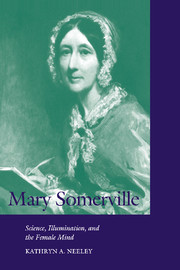Book contents
- Frontmatter
- Contents
- Author's Preface
- Key to Parenthetical References to the Works of Mary Somerville
- Prologue: Perceiving What Others Do Not Perceive: The “Peculiar Illumination” of the Female Mind
- 1 Head among the Stars, Feet Firm upon the Earth: The Problem of Categorizing Mary Somerville
- 2 Creating a Room of Her Own in the World of Science: How Mary Fairfax Became the Famous Mrs. Somerville
- 3 Science as Exact Calculation and Elevated Meditation: Mechanism of the Heavens (1831), “Preliminary Dissertation” (1832), and On the Connexion of the Physical Sciences (1834)
- 4 The Earth, the Sea, the Air, and Their Inhabitants: Physical Geography (1848) and On Molecular and Microscopic Science (1869)
- 5 Mary Somerville on Mary Somerville: Personal Recollections (1873)
- 6 Memory and Mary Somerville: In the Public Eye and Historical Memory
- Epilogue: Science, Voice, and Vision
- Selected Bibliography
- Index
Author's Preface
Published online by Cambridge University Press: 30 March 2010
- Frontmatter
- Contents
- Author's Preface
- Key to Parenthetical References to the Works of Mary Somerville
- Prologue: Perceiving What Others Do Not Perceive: The “Peculiar Illumination” of the Female Mind
- 1 Head among the Stars, Feet Firm upon the Earth: The Problem of Categorizing Mary Somerville
- 2 Creating a Room of Her Own in the World of Science: How Mary Fairfax Became the Famous Mrs. Somerville
- 3 Science as Exact Calculation and Elevated Meditation: Mechanism of the Heavens (1831), “Preliminary Dissertation” (1832), and On the Connexion of the Physical Sciences (1834)
- 4 The Earth, the Sea, the Air, and Their Inhabitants: Physical Geography (1848) and On Molecular and Microscopic Science (1869)
- 5 Mary Somerville on Mary Somerville: Personal Recollections (1873)
- 6 Memory and Mary Somerville: In the Public Eye and Historical Memory
- Epilogue: Science, Voice, and Vision
- Selected Bibliography
- Index
Summary
In one of her best known poems, George Eliot wrote of “the choir invisible,” the “immortal dead who live again / In minds made better by their presence.” In the work of which this book is the culmination, I have been sustained and inspired by my own Choir Invisible, who have enlarged my view of what was possible and accompanied me on what has turned out to be one of the most challenging and rewarding journeys of my life. I dedicate this book to them.
The group has many members, all of whose voices have been important, but there are four who have been particularly strong presences in this work: my grandmothers, Nina Bookhardt Neeley and Jessie Rivers Von Harten, my great aunt Myrtle Von Harten Davison, and my dear friend Ann Doner Vaughan. Their capacity to inspire and support others has not been diminished by the passage from this life to the next.
The Choir also includes Mary Somerville, whom I have never properly met but who has been an excellent companion and most agreeable subject through the years I have spent with her. I have on occasion been accused of acting too much as her advocate. On one level, of course, this charge is quite justified. For as long as I have truly appreciated what she accomplished, I have felt an obligation to help bring it to light. An unusual and fortuitous set of circumstances put me in a position to comprehend her work, and I have worked hard to help others do so. I would add that I did not begin this project as Somerville's advocate.
- Type
- Chapter
- Information
- Mary SomervilleScience, Illumination, and the Female Mind, pp. xi - xivPublisher: Cambridge University PressPrint publication year: 2001

